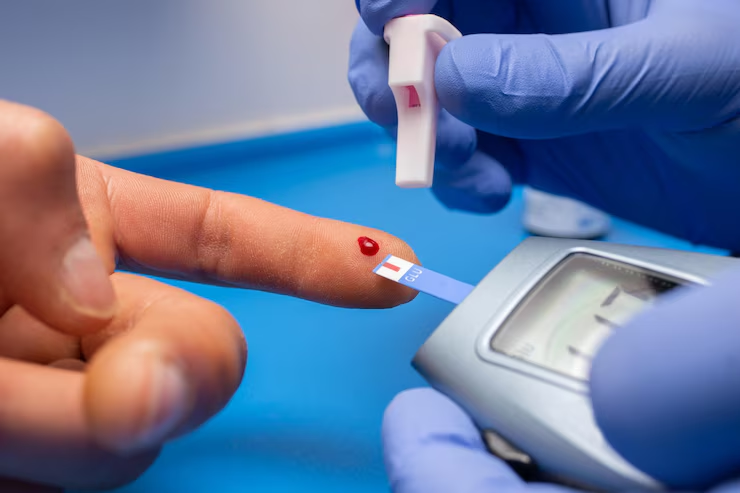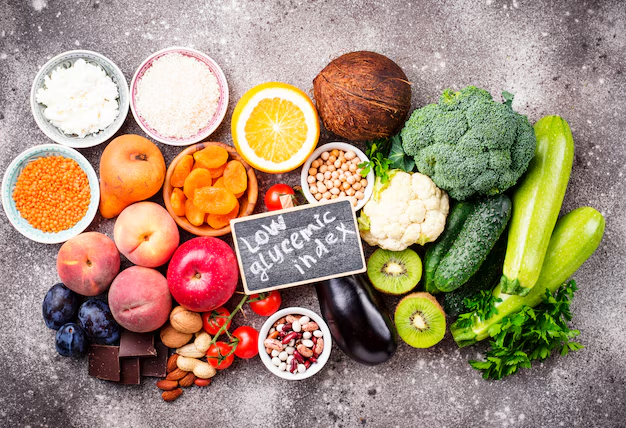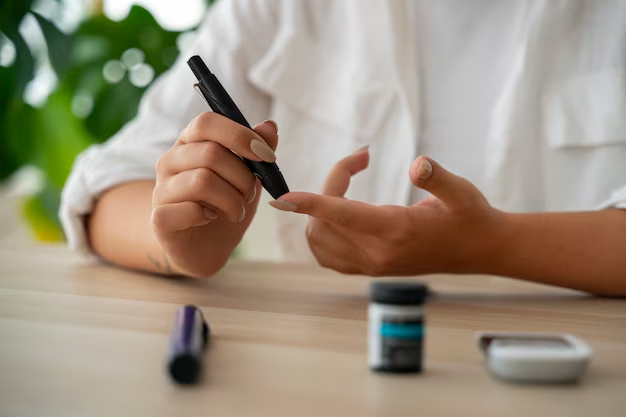Maintaining healthy blood sugar levels is very important for overall health. It helps prevent sudden energy crashes, mood swings, and long-term complications. This is especially crucial for people with diabetes, who need to monitor their blood sugar regularly to avoid both highs and lows.
Sometimes, a quick drop in blood sugar is needed when levels spike suddenly. High blood sugar, or hyperglycemia, can occur due to various reasons like stress, poor diet, or missed medication. Acting quickly to lower it can prevent symptoms from getting worse and help the body return to balance.
If not controlled, high blood sugar can cause symptoms like tiredness, headaches, and blurry vision. In severe cases, it can even lead to dangerous conditions like diabetic ketoacidosis. That’s why keeping blood sugar within a healthy range through proper diet, exercise, and timely action is key to staying well and avoiding long-term health risks.
Whether you’re diabetic or experiencing occasional blood sugar spikes, understanding how to bring it down immediately is crucial. This article explores 8 scientifically-backed, fast-acting strategies to lower blood sugar levels effectively and safely.
Understanding Blood Sugar Spikes
Blood sugar levels rise when the body either doesn’t produce enough insulin or doesn’t use it efficiently. This leads to excess glucose circulating in the bloodstream.

Common triggers include:
High-carb or sugary meals
Stress or illness
Lack of exercise
Skipping medications (in diabetics)
Dehydration
Short-term hyperglycemia requires prompt action. However, it’s also vital to address underlying causes for long-term control.
Top Immediate Strategies to Reduce Blood Sugar
Engage in Moderate Physical Activity

Engaging in physical exercise constitutes one of the most efficacious responses to the inquiry of how to reduce blood sugar level immediately. Physical activity enhances the body’s physiological responsiveness to insulin, the hormone that governs glucose regulation. During moderate to vigorous exercise, skeletal muscle tissue utilizes circulating glucose as an energy substrate, thereby diminishing elevated blood sugar concentrations through natural metabolic processes.
Even brief sessions of movement, such as brisk walking or light aerobic activity, can yield substantial improvements in glycemic levels. This is particularly advantageous in the postprandial period when glucose levels are most likely to surge. Increased muscular activity facilitates glucose uptake directly from the bloodstream, reducing hyperglycemia and mitigating the risk of acute glucose fluctuations.
Beyond its immediate effects, habitual physical activity promotes sustained improvements in insulin sensitivity, cardiovascular health, and body weight regulation. For individuals in pursuit of rapid and non-pharmacological interventions for how to reduce blood sugar level immediately, consistent exercise offers a highly effective and holistic approach.
Types of Exercise to Try:
Walking briskly for 15–30 minutes
Cycling
Light jogging
Yoga or stretching for low-impact support
Precautions:
If your blood sugar is over 250 mg/dL and you have ketones, avoid exercise—it can make things worse.
Always stay hydrated during workouts.
Tip: Keep a glucose monitor handy before, during, and after exercise to observe the impact in real-time.
Drink Water—And Plenty of It
Consuming an adequate volume of water represents a straightforward yet highly effective approach when exploring strategies for how to reduce blood sugar level immediately. Proper hydration facilitates renal function, enabling the kidneys to efficiently eliminate surplus glucose from the bloodstream via urinary excretion. This physiological process contributes to the reduction of elevated blood sugar levels and mitigates the risk of prolonged hyperglycemia.
In states of dehydration, the concentration of glucose in the circulatory system becomes more pronounced, complicating glycemic regulation. Maintaining sufficient fluid intake enhances circulatory efficiency and assists in the transport and clearance of glucose, thereby reducing systemic sugar accumulation. Moreover, consistent hydration diminishes the likelihood of complications commonly associated with persistently high blood sugar levels.
Integrating routine water consumption into one’s daily health regimen is essential for acute glucose management. As a readily accessible and non-invasive remedy, water intake should complement additional natural interventions—such as moderate physical activity or dietary mindfulness—for individuals seeking effective solutions on how to reduce blood sugar level immediately.
How Much to Drink:
Aim for 8–10 glasses a day.
If blood sugar is high, drink 1–2 glasses immediately to start the process.
Bonus: Adding lemon juice (without sugar) can help enhance detoxification and keep blood sugar stable due to its low glycemic impact.
Take Rapid-Acting Insulin (If Prescribed)

For individuals diagnosed with insulin-dependent diabetes mellitus, the administration of fast-acting insulin serves as an essential therapeutic modality for addressing acute elevations in blood glucose. During episodes of hyperglycemia, the timely and precise delivery of an appropriate insulin dosage can facilitate a rapid return to euglycemic levels. This pharmacological intervention is widely recognized within clinical protocols as a dependable strategy for how to reduce blood sugar level immediately in urgent scenarios.
Fast-acting insulin formulations initiate their physiological effect within minutes of administration, promoting the expedited uptake of glucose by peripheral tissues. This mechanism effectively mimics the body’s natural insulin response, particularly following the consumption of high-carbohydrate meals or during periods of physiological stress or illness—conditions known to elevate glucose concentrations. Nevertheless, strict adherence to a healthcare provider’s guidance is imperative to avoid potential risks associated with incorrect dosing.
Utilizing fast-acting insulin demands conscientious monitoring and responsible application. While it provides a powerful and efficient solution for how to reduce blood sugar level immediately, its effectiveness is maximized only when integrated into a broader framework of regular glucose surveillance and individualized medical oversight.
How to Use:
Follow your healthcare provider’s guidelines.
Use a glucose meter or CGM (continuous glucose monitor) to determine how much insulin is needed.
Caution:
Overdosing can cause hypoglycemia.
Always have a snack ready in case your sugar drops too low.
Eat Low-Glycemic Foods Immediately
When looking for natural ways on how to reduce blood sugar level immediately, choosing high-fiber, low-GI foods can be very helpful. These foods slow down the digestion process, allowing glucose to enter the bloodstream more gradually. This helps avoid sudden spikes in blood sugar levels after meals.
Foods like oats, lentils, non-starchy vegetables, and whole grains are good examples. They don’t cause sharp rises in blood sugar and help the body manage glucose more effectively. Fiber also supports better gut health, which can further improve blood sugar control.
While they may not act as fast as insulin or exercise, these foods still play a key role in managing high sugar levels safely. Eating a small portion of a high-fiber snack when levels are high can help promote a steady and healthy decline. This approach is both simple and sustainable for long-term care.
Best Options:
Avocados
Nuts and seeds (almonds, chia seeds)
Leafy greens (spinach, kale)
Whole oats or barley
Avoid:
White rice
Bread
Candy or soda (unless treating low blood sugar)

Quick Recipe: Try a small bowl of Greek yogurt with chia seeds and cinnamon—high protein, fiber, and naturally blood-sugar-friendly.
Take Apple Cider Vinegar (ACV)
Apple cider vinegar (ACV) is frequently regarded as a natural and accessible intervention when investigating methods for how to reduce blood sugar level immediately. Consuming ACV prior to meals has been shown to enhance insulin sensitivity, thereby allowing the body to respond more effectively to insulin and promoting more efficient glucose utilization within the bloodstream.
Scientific studies indicate that ACV can attenuate the glycemic response following the ingestion of carbohydrate-rich foods. This is primarily achieved by decelerating gastric emptying, which in turn moderates the rate at which glucose enters the circulatory system. A modest dosage—such as one to two teaspoons diluted in water before meals—may contribute to improved postprandial glycemic regulation.
While ACV should not be considered a substitute for evidence-based medical treatment, its inclusion in a structured dietary regimen may offer complementary benefits in the context of blood sugar management. For individuals seeking sustainable solutions for how to reduce blood sugar level immediately, ACV presents a practical and economical adjunct, though professional medical guidance is strongly recommended prior to use.
How to Use:
Mix 1–2 tablespoons in a glass of water.
Drink before meals or when experiencing a sugar spike.
Note:
Avoid taking it on an empty stomach if you have ulcers or acid reflux.
Look for organic, unfiltered ACV with the “mother.”
Manage Stress Through Breathing and Relaxation Techniques
Psychological stress exerts a significant and often underestimated influence on glycemic regulation, and comprehending this relationship is vital when exploring methods for how to reduce blood sugar level immediately. During periods of heightened stress, the endocrine system triggers the secretion of cortisol—commonly referred to as the stress hormone—which instructs the liver to release its stored glucose into the bloodstream. Although this biological mechanism is designed to provide rapid energy for the body, it frequently results in unanticipated elevations in blood sugar levels.
For individuals diagnosed with diabetes or experiencing insulin resistance, these stress-induced spikes can present substantial challenges in glucose management. Emotional distress, sleep disturbances, or chronic anxiety can elevate blood glucose levels even in the absence of food intake. Consequently, the implementation of effective stress-reduction techniques becomes a crucial component of comprehensive blood sugar control.
To actively address elevated glucose caused by stress, engaging in relaxation practices such as deep-breathing exercises, mindfulness meditation, light physical activity, or stretching can be highly beneficial. These strategies help attenuate cortisol production and foster a calming physiological response, thereby contributing to glucose stabilization. Integrating such practices into daily routines enhances emotional well-being and serves as a practical, natural approach for how to reduce blood sugar level immediately.
Fast-Acting Stress Busters:
Deep belly breathing for 5–10 minutes
Guided meditation apps (Calm, Headspace)
Progressive muscle relaxation

Pro Tip:
Use the “4-7-8” breathing method:
Inhale for 4 seconds
Hold for 7 seconds
Exhale slowly for 8 seconds
Get Adequate Sleep—or At Least Power Nap
Adequate and restorative sleep plays an indispensable role in the regulation of blood glucose, particularly when addressing strategies on how to reduce blood sugar level immediately. Insufficient sleep disrupts the delicate hormonal equilibrium within the body, notably elevating cortisol levels and diminishing insulin sensitivity. These imbalances collectively contribute to an increase in circulating glucose, exacerbating hyperglycemic conditions.
Even a solitary night of inadequate or fragmented sleep can adversely affect glucose metabolism the following day. During such periods, the body’s efficiency in utilizing insulin is compromised, leading to suboptimal processing of dietary sugars. Prolonged sleep deprivation may gradually intensify insulin resistance, heightening the risk of recurrent glycemic fluctuations and long-term metabolic disorders.
To enhance glycemic stability, individuals should prioritize achieving 7 to 9 hours of uninterrupted, high-quality sleep each night. In moments of acute elevation, resting in a quiet, darkened environment may assist in physiological recovery. Incorporating proper sleep hygiene remains a valuable addition to the toolkit for how to reduce blood sugar level immediately.
What to Do:
If it’s late in the day and you’re tired, take a 15–20 minute nap to reduce cortisol and balance your glucose levels.
Ensure 7–8 hours of sleep every night for long-term blood sugar regulation.
Bonus: A short nap can also reduce hunger cravings that could lead to overeating sugary snacks.
Monitor Your Blood Sugar Frequently
Monitoring blood glucose levels in real time represents a highly effective and empowering approach for individuals seeking how to reduce blood sugar level immediately. This method allows for a precise understanding of the body’s glycemic response to various factors such as dietary intake, emotional stress, physical activity, and sleep patterns. By continuously observing these fluctuations, individuals can implement timely and informed interventions to promptly restore glucose levels to a healthier range.
Devices such as glucose meters and continuous glucose monitors (CGMs) provide instant feedback, enabling swift corrective actions—like engaging in moderate exercise, increasing hydration, or modifying food choices—to be taken at the first sign of a blood sugar spike. These tools not only offer immediate benefits but also contribute to longer-term glycemic awareness.
Furthermore, real-time monitoring offers valuable insights into the success of your interventions. Whether it’s a brisk walk or increased water intake, you can observe their direct impact, reinforcing practical methods for how to reduce blood sugar level immediately.

Best Practices:
Use a Continuous Glucose Monitor (CGM) or finger-prick test.
Track your levels before and after meals, exercise, or medication.
Suggested Tools:
FreeStyle Libre
Dexcom CGM
Accu-Chek or Contour glucometers
What NOT to Do During a Blood Sugar Spike
Avoid these common mistakes, as they can worsen the situation:
Over-correcting with too much insulin
Eating sugary foods thinking it will help (only for lows!)
Skipping meals
Panicking, which can increase cortisol and worsen the spike
Lifestyle Habits for Long-Term Blood Sugar Control
While this article focuses on immediate solutions, incorporating these habits into your daily routine will prevent frequent spikes:
| Category | Key Recommendations |
|---|---|
| Balanced Diet | – Focus on whole foods – Reduce refined carbs and added sugars |
| Regular Activity | – Aim for at least 150 minutes of moderate exercise per week |
| Consistent Meal Timing | – Avoid skipping meals – Eat at regular intervals to prevent drops or spikes |
| Medication Adherence | – Take diabetes medication exactly as prescribed – Report side effects to your doctor |
| Regular Health Checkups | – Monitor A1C, insulin levels, and general health markers |
Conclusion

Managing blood sugar levels is essential for good health, especially for people with diabetes or insulin resistance. Understanding how to reduce blood sugar level immediately can help prevent complications and bring quick relief during sudden spikes. Simple actions like light exercise, drinking water, eating low-glycemic foods, and managing stress are fast and natural ways to lower high glucose levels.
For those using insulin, taking the correct dose under medical supervision is very important. Monitoring your sugar levels regularly also helps you know when quick action or medical help is needed. These steps are useful in urgent situations but should be part of a bigger health plan.
Along with knowing how to reduce blood sugar level immediately, building healthy habits like eating balanced meals, staying active, and following your medication schedule supports long-term control. By combining quick fixes with smart daily choices, you can enjoy a more stable, healthy, and active life.
FAQs
Q.1 What is the fastest way to lower blood sugar levels naturally ?
One of the quickest methods is light to moderate exercise, like a brisk walk. It helps your muscles use more glucose, which lowers blood sugar.
Q.2 Can drinking water help reduce blood sugar quickly ?
Yes, drinking water can help flush out excess sugar through urine and rehydrate the body, making it a simple way for how to reduce blood sugar level immediately.
Q.3 Does stress affect blood sugar levels ?
Yes, stress raises cortisol levels, which causes the liver to release more glucose. Managing stress is key in how to reduce blood sugar level immediately.
Q.4 Is apple cider vinegar useful for lowering blood sugar ?
Taking a small amount of apple cider vinegar before meals may improve insulin sensitivity and reduce post-meal sugar spikes.
Q.5 How does sleep impact blood sugar ?
Poor sleep increases insulin resistance, leading to higher sugar levels. Rest is an important part of how to reduce blood sugar level immediately.
